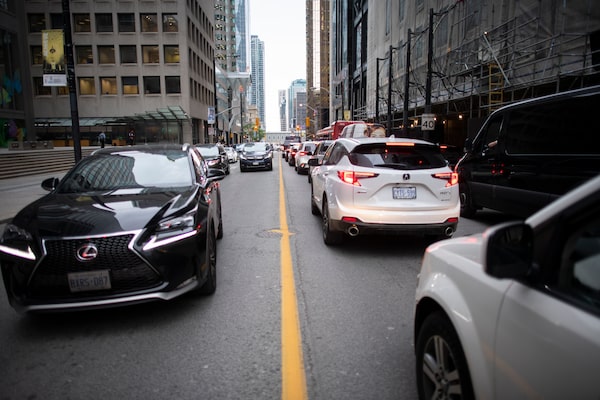
Traffic on Bay St. in Toronto’s Financial District on June 13.Fred Lum/The Globe and Mail
Several candidates in Monday’s mayoral by-election have seized on growing frustration over congested streets and long commutes in Toronto – made worse by large construction projects – as a significant issue in the campaign.
Tackling gridlock is one of the top concerns candidates said they’ve heard about from residents, and some have revived the debate about the role of bike lanes in exacerbating the problem.
Toronto is one of the worst cities in the world for congestion: Commuters are stuck in traffic for an average of 118 hours a year, according to a 2022 study from transportation firm Inrix.
The gridlock is also hurting the ability to conduct business in Toronto, the city’s chamber of commerce warned.
Toronto mayor election platform tracker: Where the top candidates stand on key issues
Toronto mayoral by-election candidates weigh in on ‘strong-mayor’ powers
Former Toronto mayor John Tory endorses Ana Bailão to replace him in next week’s by-election
The Toronto Region Board of Trade said companies are deciding to move elsewhere in Canada and many downtown businesses are having trouble establishing return-to-office plans because some employees are put off by how difficult and time-consuming it is to get around.
Incoming president and chief executive officer Giles Gherson said easing congestion is one of the first steps the new mayor needs to take after Monday’s vote. He pointed to the need for a better bike lane strategy on main streets, arguing that the impact on vehicle traffic and the ability to move goods isn’t being fully taken into account.
“There’s this lack of planning,” Mr. Gherson said during a recent meeting with The Globe’s editorial board. “It really is something we’ve got to start taking to heart. We have to have objectives for our policy sets so it isn’t just random and we’ll see what happens and shrug our shoulders at the end.”
Construction of the Eglinton Crosstown LRT and the Ontario Line subway project have caused road closures in the core, including several blocks on the major corridor of Queen Street.
Toronto’s transportation department said in a statement that it is responding to congestion challenges this summer through a number of initiatives, such as deploying traffic agents to high-volume intersections and launching six construction hubs that allow for oversight and co-ordination of several projects in a specific area.
The city also has more technology and traffic management tactics available than before, including 59 smart signals that use real-time data, with 30 more being installed this year.
Mayoral candidates have been pitching their plans to improve mobility.
Onetime newspaper columnist Anthony Furey and former police chief Mark Saunders have both taken issue with dedicated bike lanes on arterial roads, including Yonge Street and University Avenue, and promised to remove them if elected.
Mr. Furey said he supports bike infrastructure on side streets and would add more stretches of bike lanes, but not as much as the 500 kilometres in the city’s plan. He also would pause the RapidTO program that allocates lanes on select main streets for buses only.
“Drivers tell me nothing is more frustrating than sitting in traffic, not moving, looking beside you and seeing either a traffic lane painted red that they can’t drive on or a bike lane where a traffic lane used to be where there are no bicycles using them.”
Mr. Saunders said he would immediately suspend all bike lane expansion plans and launch consultations with residents and businesses. Council recently approved about nine kilometres of additional bike lanes, expanding the network beyond the city’s core.
Data from the city shows cycling on most main roads with bike lanes has grown since their installation. Cycling volumes grew up to 180 per cent on Yonge Street between May and October, 2022, while vehicle volumes dropped up to 11 per cent.
Traffic experts say several factors are causing Toronto’s congestion problems and many solutions need to be involved, including alternative transportation options, better planning around lane closures for construction and increased use of technology to monitor intersections and control traffic signals.
Professor Matti Siemiatycki, director of the Infrastructure Institute at the University of Toronto’s School of Cities, said better bike networks “have to be an alternative” in the core and moving lanes off arterial roads isn’t the answer because there aren’t direct enough routes.
Professor Eric Miller, director of U of T’s Transportation Research Institute, said the new mayor’s first priority to address gridlock should be to expand transit, including reversing an “absurd” series of cuts in service implemented earlier this year.
Perceived front-runner Olivia Chow, a former NDP MP and Toronto city councillor, said removing bike infrastructure would have “deadly consequences” and she would expand the network of bike lanes. She also plans to make transit more reliable by increasing service and adding routes.
Former councillor Ana Bailão has focused on improving the transit system and incentivizing usage with lower costs on select routes where construction is worsening travel times for commuters.
 Dustin Cook
Dustin Cook